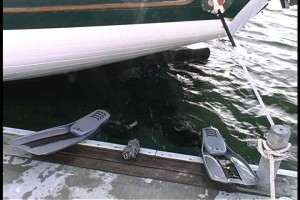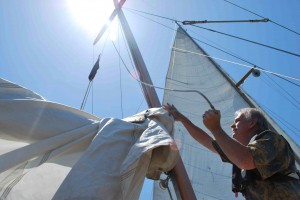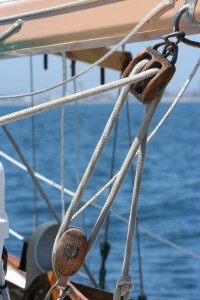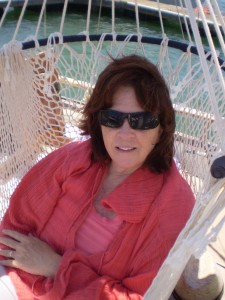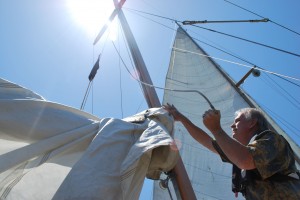It has been a long watch Christmas Eve on the passage from Ventura to San Diego. An hour before sunrise, a blood red, full moon slips below the horizon foretelling the storm that has been chasing us southward. Catalina is somewhere off the starboard bow and we barely move on a flat, windless sea.
I really should wake Jan for her watch. I am so tired I can barely sit upright behind the wheel. It is bitter cold and the wool blanket on my lap and the one wrapped tightly around my shoulders just makes my watch tolerable. I can’t bear to wake her, so another hour passes before Jan wakes me with a start, “John? Are you okay?”
I mumble something and bolt upright. The eastern sky is pale and overcast. “I’m fine honey. Merry Christmas,” I add.
“Merry Christmas John! Would you like some hot tea?”
“I’d love a cup.” Still the sails hang limp. The northern skies look menacing but the radio says we still have another day before the gale will arrive.
We were scheduled to leave Ventura on Monday but the starter had to be replaced and the myriad of tiny chores proved to be nearly insurmountable. Beautiful day followed beautiful day but we were still trapped at the marina. “Jamma” took her sewing machine home on Monday and our dear friends, Gordon and Glynna, stretched their vacation until Wednesday to help us prepare. The weather closed in on Thursday but we slipped the lines on Friday and roared across the channel past Anacapa Island with a rail in the water on only the jib and mizzen sails.
“According to sailing lore, voyages that start on Friday will surely end in disaster,” Terry the salty old diesel mechanic at the marina reminded us before we left. His words haunted me all through my first overnight passage as did the dictum repeated as the moon sank before dawn, “Red sky in the morning, sailors take warning.”
“Merry Christmas sailor,” she chimed handing me a steaming mug of tea. Catalina Island finally appeared in bold relief as the edge of the sun crept above the horizon. Birds began their search for breakfast and a playful pod of dolphins frolicked in the distance. My joints ached as I stood to stretch. Jan dutifully slipped behind the wheel and I wrapped the blankets around her. There really was no need to steer. There wasn’t a hint of wind but the slow, ocean swells continued to move us south.
Christmas at sea! The kids have all been raised and there weren’t any grandchildren to share the holiday with. It was just the two of us born along on our magical sailboat. Santa Teresa is a fine old classic wooden ketch. Sailboats are more than a mode of transportation. They speak to you and shelter you. She is full of life! The giant, plastic, powerboats – the yachts of fiberglass and chrome, electronics and egos – are objects of conspicuous consumption, but a wooden boat powered by wind and wave seems to define your place in the universe. It is almost a mystic experience. You learn your location from the stars. You change your location by cooperating with nature. Your hull sprang from the life of ancient trees instead of a chemistry set.
We sat, sipped our tea and meditated on the morning. Then I went below and re-emerged with our foot tall Christmas tree. I put my crudely wrapped package for Jan under the tree and she gave me a kiss producing a beautiful leather bound journal for me. Then we heard it. The sound of the sea as a thirty-foot whale, a Christmas whale, broke the surface and spouted beside our boat. He was only there for a moment before rolling down again, his giant fluke pointed towards the sky. Merry Christmas world! We hugged and laughed like children.
Elsewhere there are wars and rumors of war, chaos and calamity, pain and pollution but for two lone sailors born along in a beautiful wooden boat, life is good. Merry Christmas indeed!


